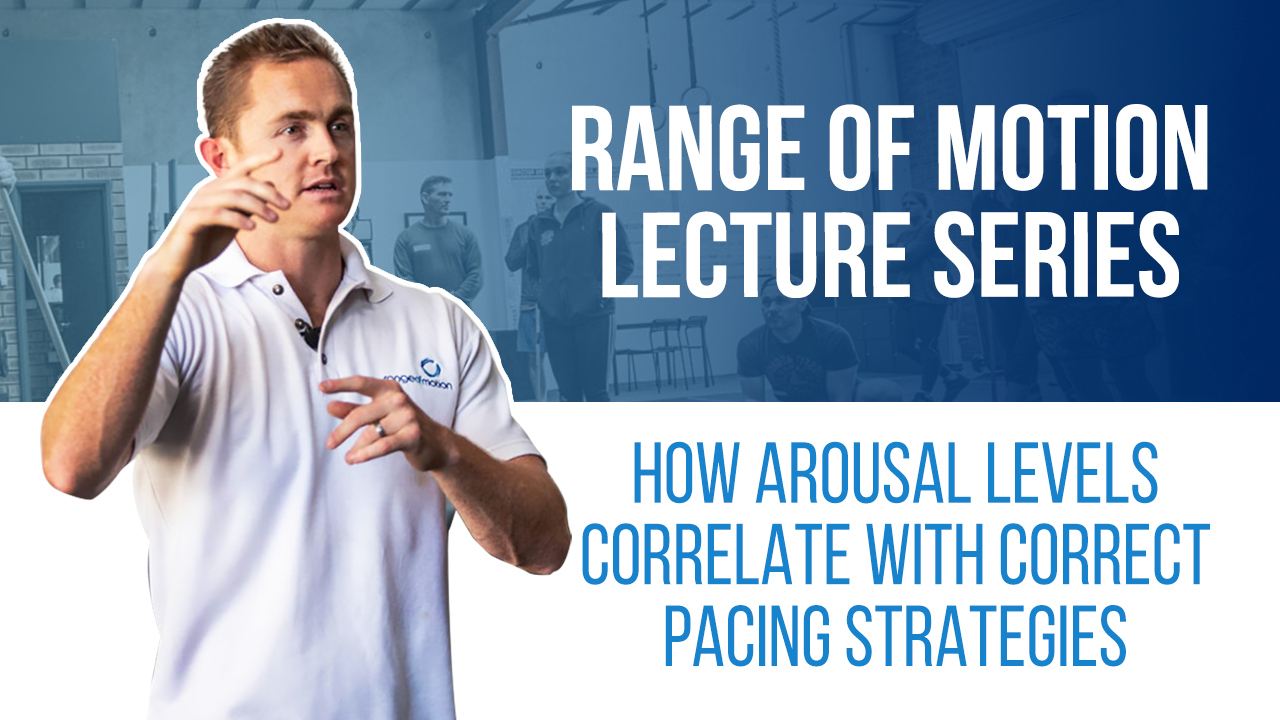Transcribed from video:
– We talk about arousal levels, and this inverted U of performance where too much arousal, hyperarousal, is causing a reduction in performance, being push out of the zone, being too anxious. And, we talk about strategies to bring that down. The Inverted U model, and I had a question on this yesterday I think, the inverted U model, its ideal performance state, IPS, equals your maximum sustainable intensity. I think the question was related to the intensity that you’re working at, does that come down to how fired up you are as well? This is where we get the overlap between the energy system training we talked about, and the mental skills training we talked about. The overlap here is that, you being in the ideal performance state, in the zone, is going to allow you to find your maximum sustainable intensity. If you’re hyperaroused, your sitting this side of that goldilocks-perfect area. Hyperaroused stress, what speed do you think you’re going to start at? Too fast. You’re too fired up, you’re too fired up for the event. Now this curve, remember, moves by some of the event. We talked about it moving whether you’re doing a max deadlift or going to a poker tournament, yeah? If you’re knitting your ideal performance state is going to be this end of the arousal continuum. So, our ideal performance state equals our maximum sustainable intensity. If you’re under-aroused, what’s going to happen to the pace that you start out at? It’s going to be too slow. And you won’t be creating a high enough yield of this cycle of rare touching the phosphine molecule to ATP to create ATP so you can start that cycle again. So, you can see how there’s a big relationship here. Can you all think of someone who, they always start off a little bit too slow, it’s definitely not as prominent starting out too fast, but they often start out too slow. Is that person probably pretty chill, they’re a little lower on the arousal level, somebody who maybe needs to listen to heavy metal music a little bit more rather than stuff to calm them down. As opposed to someone who always starts off too fast, you guys all see him, who does that? Or overenthusiastic at the start, going for it, going for it, going for it. That’s the sort of person who needs to be listening to Beethoven before they start, not listening to death metal. Alright. Yeah, just swap your playlist. Easy, problem solved. So, it’s about you changing those arousal levels, you psyching yourself up, psyching yourself down, to match the length of the event that you’re about to perform in. We talked about the muscle tension and coordination difficulties. The people who are running at 105% of their max versus the people who are running at 95% of their max. Those trying to overdo it, do too much, have this muscle tension, they lose their coordination, the lifts don’t feel good because there’s a co-contraction, all their joints are on and they’re too tight. 95% effort is more effective than 110% effort.
– [Woman] How does this practise, the more competitions you do, the more you know where you’re at?
– I’ll come to that. Yeah, it’s self awareness, and it’s part of the argument because a lot of people say “but you shouldn’t pace in training, should you?” Because if you pace in training, you’re not getting the fitness benefits, and that’s a valid. But it’s actually not, and we’ll talk about the signs and why that’s the case as we get there. There’s that side, but then there’s another argument as well which is even more compelling. Has anyone heard of the term festina lente? It’s a Latin term and it loosely translates as slow is smooth, smooth is fast. Slow is smooth, smooth is fast. It’s something that I have drummed into my athletes again and again and again. The slow is smooth. if you go slow, you’re moving well. You’ll see the top level athletes, if you watch the crossfit games, they never look rushed. There’s a big difference between fast and rushed. These guys are fast, but they never look flustered. The people next to them who do look flustered and who do look rushed, they look like they’re moving quicker. Yet, suddenly, this guy who’s just slowly moving through his box jumps, how come he’s moving his box ahead when he’s moving so much slower? Festina Lente. F-e-s-t-i-n-a L-e-n-t-e Slow is smooth, smooth is fast. It’s a really good motto for a lot of stuff, not just exercise. Another translation is make haste slowly. So, it doesn’t mean you’re not doing stuff, it just means you being fast as opposed to being rushed.





